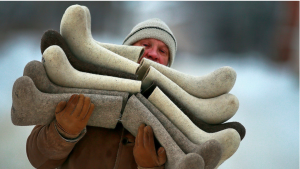1
“There are many enthusiastic heads—/ Having forgotten their own country,/ They fly away on rockets/ for a walk on the moon…"
2
The man on the rocket is dressed in traditional peasant attire: a belted tunic, work boots, and a flat cap. The tunic is red, representing both communism and the ease of printing things in red, due to available printing technology at the time of publication.
3
The illustrative pairing of a peasant-looking man with a rocket in outer space emphasizes the accessibility of science and advancing technology for all Soviet people
4
The image of the Earth is printed with Europe and Africa visible. At the time of publication the Soviet Union had not yet begun its formation of the Eastern Bloc in Eastern Europe, or its colonization of African countries, but the centering of both continents indicates their importance to Soviet Union political, economic, and social goals of subsequent decades.
5
"For a long time Grandfather Ipat/ has had in use an automatic saw,/ shovel, and electric axe."
6
The old man is dressed in simple clothes. They appear to be warm and not very ornate, with bland patterns and mostly in the color brown. This may be to reinforce him being an old man, or perhaps to indicate that even poorer people will be able to use the fantastic machines he is using here.
7
The image of automated machines would seem to promise a future for the Soviet people free from hard labor, where even people like the old man pictured here can accomplish much by doing little.
8
The old man wears Valenki boots, which were felt shoes commonly worn by peasants during the winter months.
